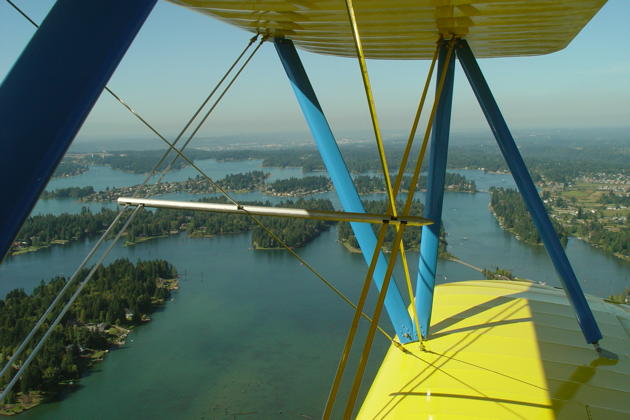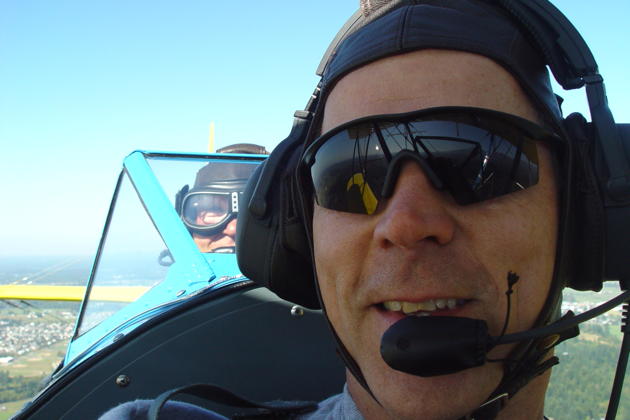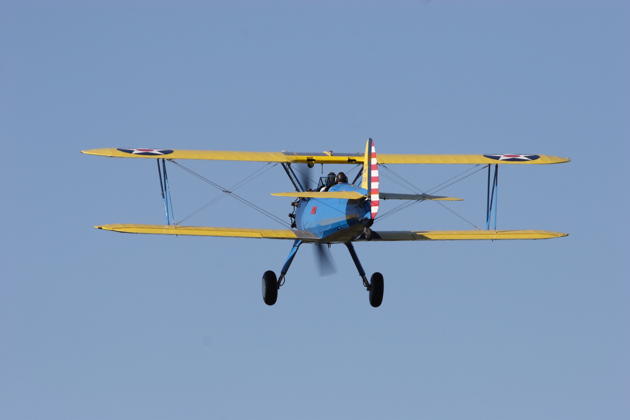FlightLog Archive
∟Aircraft Flown
Flying the Stearman PT-18 - Sep 2008
The Stearman Model 75 is a sturdy classic biplane, built in the US during the 1930s and 1940s as a military trainer aircraft. Stearman, which became a subsidiary of Boeing in 1934, built 8584 Model 75s, as a primary trainer for the USAAF (as the PT-13, PT-17 and PT18), as a basic trainer for the USN (as the NS1 and N2S), and with the RCAF as the Kaydet. In the USAAF variants, the three different designations were based on the power plant. The PT-13 has a Lycoming R-680 engine, the PT-17 has Continental R-670 engine, and the PT-18 has a Jacobs R-755 engine. A later version supplied to the Royal Canadian Air Force, some of which featured a cockpit canopy, was designated the PT-27.
While attending Rich Alldredge's retirement party from Boeing a few years ago, he mentioned that he had rebuilt a Stearman, and offered the opportunity to fly it some time in the future. After touching base with Rich this summer, I found out he was completing some major engine work, but hoped to have his Stearman flying again in late summer.
In mid-September, I talked to Rich, and he said that the engine was back on, and he invited me to his home and hangar at Evergreen Sky Ranch airport, near Black Diamond, WA, for a flight in his Stearman. We scheduled an early afternoon flight, and I arrived during a glorious late summer afternoon in the Northwest. Rich's home and hangar are located right on the Evergreen Sky Ranch grass strip, and the Stearman gleamed as I walked up to it in the afternoon sun. Rich gave me a great walk around and orientation, where I got a close hand look at the workmanship and impeccable finish of his PT-18. It's literally a museum quality aircraft that flies!
In our walk around, I was surprised to find ailerons only on the lower wings, and not on the upper. Rich stated that was the standard configuration, which made for less than brisk roll performance. Some Stearmans have been modified with upper surface ailerons to increase roll authority. Robust hand holds were built in to the side fuselage, just forward of the tail, and on the outboard edges of the lower wing, to ease in ground handling, allowing us to reposition the PT-18 easily for some photographs. Rich stated that the Stearman was built like a tank, and the only item to treat carefully were the windscreens, which were not as strong as the rest of the aircraft, but did deflect the windstream quite well.
Entry into the cockpit was quite easy, again due to large handholds on the upper wing, and Rich explained the basic cockpit controls and instrumentation. The aft cockpit is normally used when flying solo, but Rich noted that his engine and CG configuration allow solo flight from either cockpit. Today, Rich took the rear and I took the front cockpit. The fuel gauge has a unique visual tube system hanging from the center fuel tank, which showed the status of the 46-gallon upper wing tank. We donned our leather helmets and headsets, and Rich easily cranked the engine for our ground warmup. Once the oil temperature reached 80 degrees, we trundled down the grass taxiway and performed a runup at the south end of runway 34.
The main landing gear are closely spaced on the Stearman, and the throttle must be advanced smoothly on takeoff and the tail allowed to rise on its own, to ensure good directional control with the rudder. Rich taxied into position and smoothly ran up to full power, and we quickly accelerated on the hard grass strip, raised the tailwheel, and lifted off into the glorious afternoon sky. At full power and with the wind blowing by, the only thing that made communication possible was the ANR headsets and loud voices. The visibility out the open cockpit was stunning, especially as we turned tightly after takeoff and descended for a flyby down the runway in the opposite direction.
Rich let me have the airplane, and I was surprised at how little rudder was needed to stay coordinated in turns. As noted earlier, the ailerons were effective, but not really crisp. Pitch forces were light as I figured out the needed pitch attitude for level flight, which we actually didn't maintain for long. I cruised down to overfly the neighborhood of a friend in South Prairie, and then Rich took over for a low approach and flyby at Cawleys South Prairie airport. The airport is unique in that a road cuts through about 2/3 down the available runway, with a large "STOP" sign on the runway at the 2/3 point. We definitely woke up a passing car as we flew overhead.
I continued northwest and took the Stearman over Lake Tapps, enjoying the stunning open-cockpit view over the waters. Although the biplane wings, struts and wires are evident, they fade from view as you absorb the impressive view from the open cockpit. We overflew the Washington National Golf Club southeast of Auburn, then flew a great a low altitude run down the White River as it meanders between Auburn and Enumclaw. It was a great coordination exercise, since the goal was to follow all the tight bends and twists in the river, and the Stearman flew the turns and twists easily.
Besides being a perfect day for sightseeing, it was also a perfect day for some maneuvering, so Rich took over for some lazy 8s and wingovers to show the capability of the Stearman - very enjoyable!
I headed back to Evergreen Sky Ranch, and Rich took over for a final pass down the runway, then an entry into downwind. The Stearman has a reputation for being very tricky in crosswinds, but our light wind conditions helped Rich make a very smooth touchdown and rollout on the grass of runway 34.
Thanks, Rich, for a picture perfect example of open-cockpit biplane flying. You've just reinforced that desire for a tail dragger rating!
 KASPRZYK
KASPRZYK













